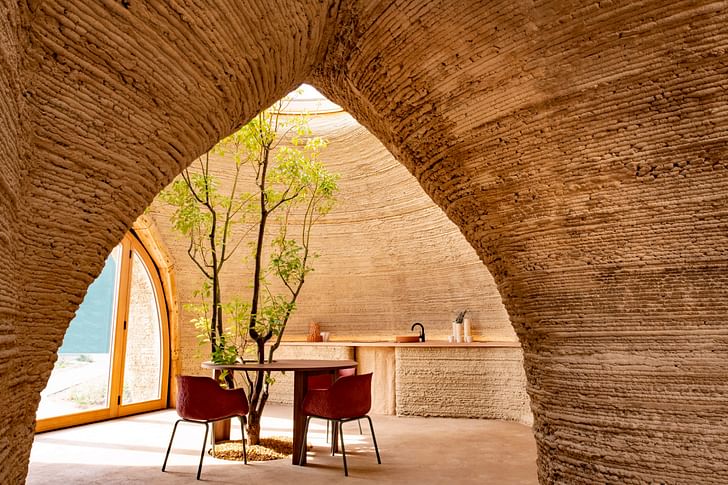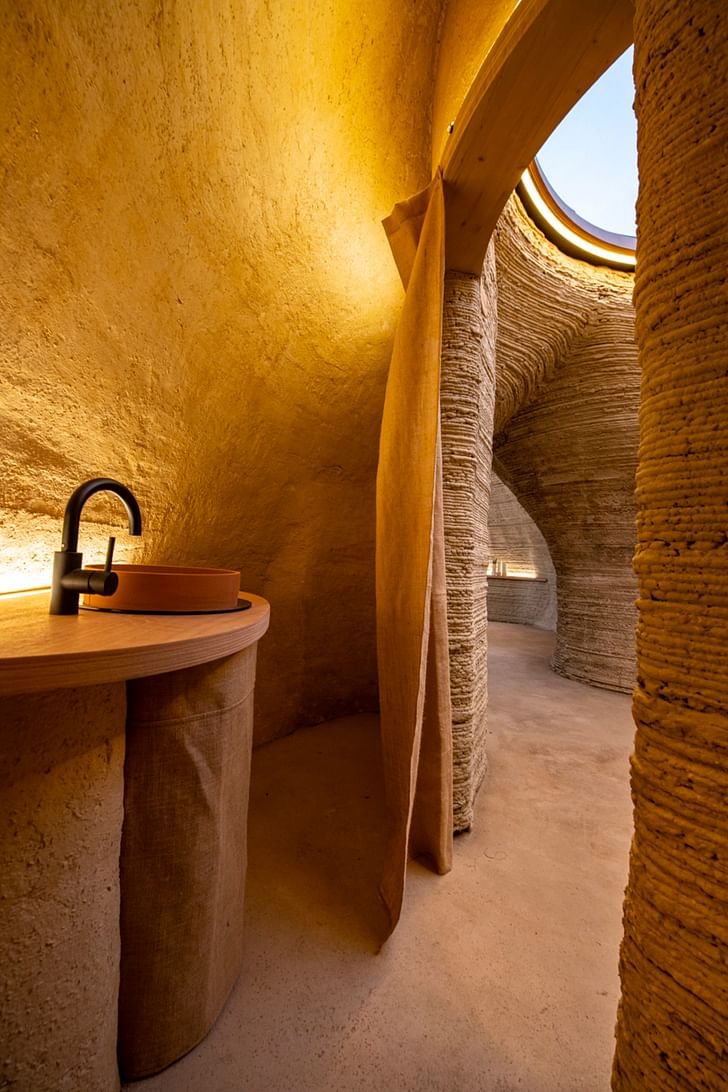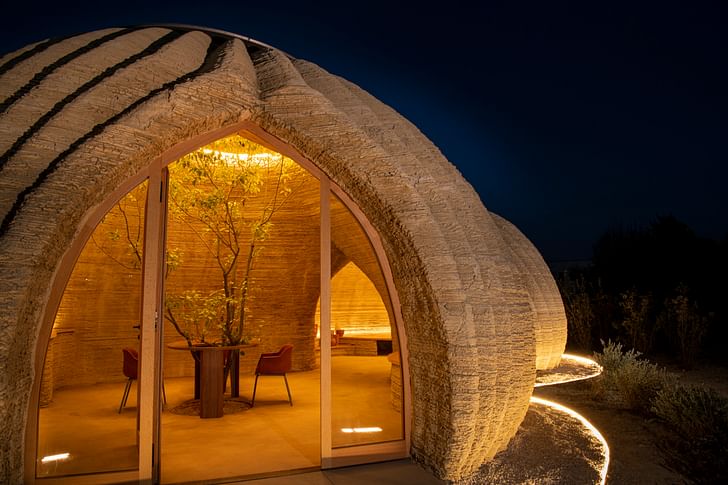

When TECLA was unveiled to the world at the beginning of 2021, it captured the attention of both the architectural community and the imagination of the mainstream media. The world's first 3D-printed house made from raw earth, TECLA was one of 17 projects showcased at COP26 in an exhibition highlighting pathways for the built environment to reduce its carbon footprint.
For Mario Cucinella, the architect behind TECLA, the project represents a broader conviction to “imagine a world where beauty is soulful and sustainable.” This same conviction has seen Cucinella and his team at Mario Cucinella Architects establish not only a portfolio of projects driven by dual principles of sustainability and creativity, but an in-house School of Sustainability encompassing environmentally-themed education, research, and practice.
Archinect’s Niall Patrick Walsh sat down with Cucinella recently at the 2022 World Architecture Festival in Lisbon, Portugal for a wide-ranging discussion encompassing the firm, the story behind TECLA, and Cucinella's broader thoughts on sustainability, the architectural profession, and the future. The conversation, edited slightly for clarity, is published below.
Niall Patrick Walsh: To begin, could you give an overview of Mario Cucinella Architects as it stands in 2023?
Mario Cucinella: We have been based in Bologna, Italy since 1999, and in 2018 opened an office in Milan. We have approximately 110 people between the two offices, with some working on live projects and others involved in research and development with a focus on sustainability, and keeping the rest of the office informed about the latest environmental thinking around the world.
There’s a heavy mixture of typologies and scales across your portfolio. Is there a consistent theme or principle that unites all of your work together?
There are two core principles for projects in the office. One is empathy with the environment. This is something we need to think about from the beginning of the project. It goes beyond features and functions; it also includes a deep understanding of context, being open to exploration and experimentation, and collecting and reading data and information.
Considering environmental issues at the beginning of the project can help us drive the project in the right direction. ― Mario Cucinella
The second is what we call ‘creativity with empathy,’ which takes this understanding of place and connects it to the physical, the cultural, and the social. To merge these two principles, we seek to control creativity using the environment and the given program. This is how we begin every project. Ultimately, considering environmental issues at the genesis of the design process can help us drive the project in the right direction, and to give us the chance to produce the best architecture we can, embedded in a respect for nature.

One particular project of yours that has captured people’s imagination is TECLA, designed by Mario Cucinella Architects and built by WASP, which is considered the world’s first 3D-printed raw earth house. Approximately one year ago, I spoke with an architect in Arizona who had recently designed and delivered a 3D-printed house and described to me some of the challenges he faced. It’s still a novel process in construction, and in his case, there was a high degree of troubleshooting on-site dealing with machine limitations, timescales, fenestrations, and building codes. Did your team face similar challenges with TECLA?
Certainly. 3D printing is still a new construction technology in itself, but when we combined it with the material requirements of earth, it brought further challenges. Earth is traditionally compressed when used in construction, but in this case, it was being poured from a nozzle. This changes the behavior of the material. We also encountered environmental challenges such as the external face drying faster than the internal face, which creates cracking.
For us, the challenges were in the material far more than the delivery technology. We are working now with companies on how to create additives for the earth which can help control how the material responds to weather and temperature changes across the day and seasons. For example, we are looking at how natural fibers can be added to create binds between the printed layers and allow us to use earth in a more measured, predictable way. Even if we sacrifice 10% of the material composition to these additives, and use earth for the remaining 90%, that is a major step forward.

Changing the methodology of construction is one thing, but we also need to seriously investigate how we could build without concrete at all. ― Mario Cucinella
The industry is becoming much more effective now at 3D printing with common materials such as concrete, but I only see this as only a half-innovation. Changing the methodology of construction is one thing, but we also need to seriously investigate how we could build without concrete at all. The difference between a person pouring concrete versus a machine pouring concrete, I don’t find as interesting. The work that captures my imagination is about materials, and how we can mitigate carbon costs such as transport and treatment. There may still be a future where we use concrete in an intelligent, measured, strategic way, but if we can reduce that material use by 85%, and replaced it with less carbon-intensive materials such as raw earth, this is a massive carbon reduction for us as a civilization.
As for 3D printing itself, I believe it makes sense in some conditions, but not everywhere. I would be cautious about saying that it is “the future.” I instead see it as part of the future.

This is a similar conclusion I heard from my previous conversation with the architects in Arizona. They noted that 3D printing is not a one-size-fits-all solution, but is instead an option to be evaluated depending on the design context. Interestingly, they suggested that curved, parabolic structures such as TECLA are an example of forms that could benefit from 3D printing. Do you have thoughts on this, and in what conditions 3D printing could be most effectively deployed?
One consideration is certainly the availability of local materials. Part of the driving force behind TECLA was the idea that earth is available almost everywhere on the planet, and printers are relatively transportable machines. Therefore, you could mobilize an architectural form without the significant movement of materials. In some ways, TECLA’s innovation was not only the 3D printing but the digital layer that underpins the project. This included testing the design using digital means to ensure it performed structurally, but also tapping into the potential for large databases of viable solutions like a WikiHouse. The spirit of TECLA was to say that, in disaster situations for example, you could send a 3D printer and a small support team rather than shipping structures such as containers or tents. With little instruction, you could create homes, schools, medical spaces, and other functions, in a context where it may be difficult to send trucks of concrete and steel.
We are pursuing a vision where you can send a relatively small amount of hardware, supported by an incredible bank of free-flowing software, that can make real human impacts. ― Mario Cucinella
There’s a significantly large part of the world that needs this type of support. I often hear people talk excitedly about how innovations such as 3D printing can create entire cities in a Western context. But this isn’t about just creating cities. In some parts of the world, we need small-scale urbanism such as villages for people and communities who currently have nothing. We are pursuing a vision where you can send a relatively small amount of hardware, supported by an incredible bank of free-flowing software, that can make real human impacts.

There is also sometimes a tendency for 3D printing to be the defining feature of a project; that a 3D printed house is important or notable simply by the virtue of being a 3D printed house. With TECLA, however, there is a deep level of architectural theory and emotion. You’ve previously referenced Calvino’s Invisible Cities, and ancient dwellings inspired by potter wasps, for example. Here, 3D printing is the delivery method, but not the defining element.
At the end of the day, it is a tool. I recall when digital programs and computing first entered the architectural design process. In the beginning, people were fascinated by the potential of computer-generated shapes; it was the curiosity of the day. But you very quickly realize that other factors, whether economy or empathy, remain regardless of the design technology.
As you say, the mission behind TECLA was not only 3D printing. There are several companies and universities experimenting with 3D printing already. In many situations, however, they are printed with highly-specialized materials which are valuable in a controlled, experimental, research setting but are not yet adaptable or affordable in the real world.
The value of TECLA was instead to show that there is another way to make buildings. ― Mario Cucinella
In our case, printing exclusively with earth was asking too much of the material. In our rainy climate, you need to protect the material incredibly precisely, or else it will absorb water like a sponge and become quite dangerous. You need to adapt to climates, shapes, functions, etc. The value of TECLA was instead to show that there is another way to make buildings, that we can answer a brief with an ambitious program while still reducing CO2 emissions. If you ask me right now to create an almost zero-energy, zero-emissions building, there is no way to do that using our conventional methods today.

TECLA is therefore a first step in a new direction. People sometimes ask me when we will create another TECLA, and I say: “We made this first step. We’ll make another step, but we need other architects to take what we’ve done, and make their own steps. Maybe we will take the third step together.” This is a moment where we need to share. We cannot solve this crisis ourselves, working in isolation from each other.
I’ll be that person, and ask you what your next step is!
We are making several! We are studying more shapes, and applications of those shapes. In time, we could design a village using what we’ve learned. TECLA was really pushing the curve, and pushing the material to its limits. We are now investigating how we can add a minimal level of other additives to the earth, so as to improve its stability and viability without losing the spirit of locally-sourced materials. We are also considering other typologies beyond houses.
We remain hopeful and determined, but we always have to ensure we are honest in our calculations. Developing structures for experimentation is one thing, but when developing a method or material for market use, there is a significant cost difference we need to overcome. 3D-printed earth is certainly faster than conventional methods, and if you produce a cluster of 200 buildings, it can also be much cheaper because of economies of scale. But for one-off projects, it is still complicated and costly for now.

I think when you present any piece of architecture, you will hear good-faith opinions for and against the project, on aspects such as form, aesthetics, performance, etc. Personally, I see great beauty in TECLA, but on a different level, I see a recognition in the scheme that the climate goals we will have to set for the AEC industry demand ambitious thinking that goes beyond conventional materials, processes, and forms. I’m not interested in TECLA as a solution but as a statement of intent. It says: 'As architects, we can think differently, nothing is off the table, and we always have the agency to imagine new ways of living from the ground up - literally, in this case.' It’s just my opinion, but I don’t see enough of this ambition or boldness in the profession today. What are your thoughts?
Yes, I think you are right that the success of TECLA was in the imagination of living in another kind of space. I think the space itself is fantastic. I still remember walking inside for the first time when TECLA was still under construction and saying to myself: “Wow, this is a lot more than the ‘square rooms with a window’ that we usually live in.”
TECLA might not be the future, but it is an effort to place architecture outside of its comfort zone. ― Mario Cucinella
Sometimes, I think back on past eras such as the counter-cultural ‘hippie’ movement of 1960s America. These were people who saw failures in the mainstream and wanted to live another way, even in the desert. There was a daringness; they were imagining an entirely different society. Today, I sometimes see a lack of imagination and a lack of willingness to change. TECLA might not be the future, but it is an effort to place architecture outside of its comfort zone.
In the climate context, architects need to push a new frontier. The world around us has become too conservative, too driven by money. If you only live for money, you can’t make poetry. We live in a society that demands that we move fast. But to truly go fast, you need to make the right decisions. You, therefore, need to find the space to make the right decision. You need to go slow to go fast.

Before we finish, I want to ask about another environmental initiative of yours, which is the SOS - School of Sustainability you host at Mario Cucinella Architects. When you engage with younger generations who are eager to learn more about the environment and how they can be part of solutions, does it make you hopeful about the future?
The range we see is inspiring. We have people who are at the postgraduate level, approximately 25 years old, and people older than them in their thirties or forties who have taken time away from their careers to dedicate themselves to a year of learning. They believe that in their current position, they do not feel ready to tackle future climate challenges, and are ready to learn.
I am particularly encouraged by a generation of young architects now who have embedded the problem of ecology into their work. When I studied architecture, it wasn’t like that. I was curious about it on a personal level, but it was not part of mainstream architectural culture. Now, it is a central principle. Even kids in high school experience the climate and sustainable thinking in their curriculum; it is part of their outlook.
These young people have a deep engagement with the topic, even if they don’t yet have the tools. It gives me great hope.
Niall Patrick Walsh is an architect and journalist, living in Belfast, Ireland. He writes feature articles for Archinect and leads the Archinect In-Depth series. He is also a licensed architect in the UK and Ireland, having previously worked at BDP, one of the largest design + ...
3 Comments
For those interested, this technique its being used for a long time. In Central and South America using dirt for construction is very common. Bahareque is the name, consist of mud mixed with some other natural materials, straw, small pieces of wood, etc
More information here: https://steemit.com/spanish/@a...
and here: https://es.wikipedia.org/wiki/...
Jacal in Mexico and the American Southwest...
See Nader Khalili, Racing Alone. Also Cal-Earth (on Facebook).
Block this user
Are you sure you want to block this user and hide all related comments throughout the site?
Archinect
This is your first comment on Archinect. Your comment will be visible once approved.